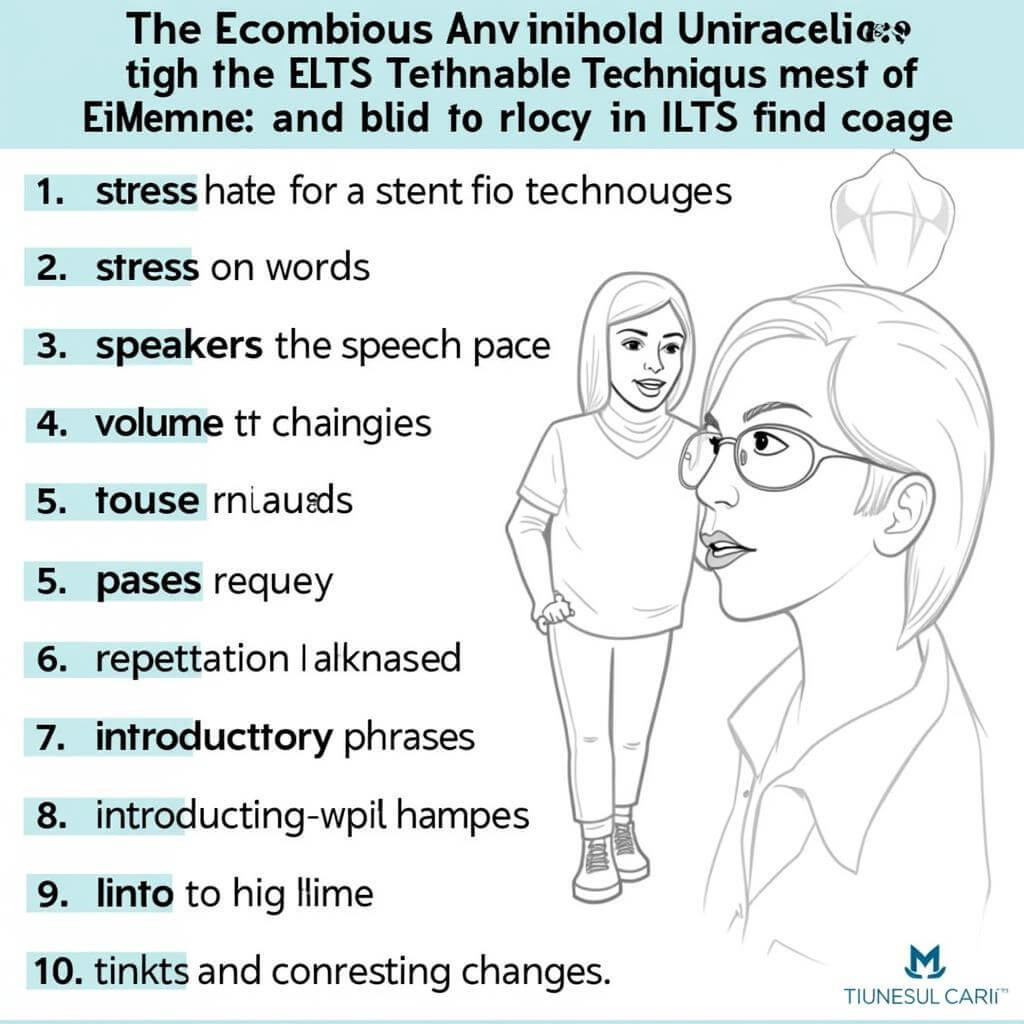In the IELTS Listening test, understanding speaker emphasis is crucial for achieving a high score. This skill allows you to identify key information, grasp the speaker’s intentions, and accurately answer questions. Focusing on main speaker ideas is essential, but recognizing emphasis adds another layer of comprehension that can significantly boost your performance.
Understanding Speaker Emphasis
Speaker emphasis refers to the way a speaker highlights certain words, phrases, or ideas through various vocal techniques. These techniques include changes in tone, volume, pace, and even pauses. By paying attention to these cues, you can better understand the speaker’s message and identify important information.
Common Ways Speakers Emphasize Information
- Stress on specific words
- Changes in volume (speaking louder or softer)
- Slowing down or speeding up speech
- Pausing before or after important points
- Repetition of key phrases
- Using introductory phrases like “importantly” or “notably”
- Changing intonation patterns
- Contrasting ideas with words like “however” or “but”

Examples of Speaker Emphasis in IELTS Listening
Let’s explore some examples of how speaker emphasis might appear in an IELTS Listening test:
- “The lecture will start at two o’clock, not three.”
- “It is CRUCIAL that you submit your assignment by Friday.”
- “The main… point… to remember… is this:”
- “First… Second… And most importantly…”
- “While some believe X, the evidence clearly suggests Y.”
- “Let me repeat that: the deadline is next Monday.”
- “Pay attention to this part, as it will be on the exam.”
- “Contrary to popular belief, the study shows…”
These examples demonstrate how speakers use various techniques to draw attention to specific information, which is likely to be relevant to the questions you’ll need to answer.
Applying Speaker Emphasis Recognition in IELTS Listening
To effectively use your understanding of speaker emphasis in the IELTS Listening test, follow these strategies:
-
Pre-reading questions: Before the audio begins, quickly read through the questions to identify potential key words or phrases the speaker might emphasize.
-
Active listening: As you listen, pay close attention to changes in the speaker’s voice, including tone, volume, and pace.
-
Note-taking: Jot down words or phrases that the speaker emphasizes, as they are likely to be important for answering questions.
-
Connecting emphasis to questions: Relate the emphasized points to the questions you’ve pre-read, helping you locate the correct answers more efficiently.
-
Practice with authentic materials: Use official IELTS practice tests and real-world English audio sources to train your ear for various types of emphasis.
Focusing on key speaker phrases is a complementary skill that can enhance your ability to identify and utilize speaker emphasis effectively.
Common Mistakes to Avoid
When focusing on speaker emphasis, be aware of these potential pitfalls:
-
Overreliance on emphasis: Not all important information will be emphasized. Some key details may be stated in a neutral tone.
-
Misinterpreting emphasis: Sometimes speakers emphasize words for emotional effect rather than to indicate importance to the task at hand.
-
Ignoring context: Emphasis should be considered within the broader context of the speech. Don’t isolate emphasized words without understanding their relationship to the overall message.
-
Missing subtle emphasis: Some speakers may use more subtle forms of emphasis. Train yourself to recognize these as well.
-
Focusing only on stressed words: While stressed words are important, also pay attention to the information immediately before and after for context.
Effective Practice Techniques
To improve your ability to recognize and utilize speaker emphasis in IELTS Listening, try these practice techniques:
-
Shadow speaking: Listen to native English speakers and repeat what they say, mimicking their emphasis patterns. This helps you internalize natural speech rhythms.
-
Emphasis prediction: Before listening to a passage, predict which words or phrases might be emphasized based on the context or questions. Then, compare your predictions with the actual emphasis used.
-
Transcription practice: Transcribe short audio clips, marking areas of emphasis. This helps you connect what you hear with written language.
-
Emphasis analysis: Listen to various speakers discussing the same topic and compare how they use emphasis differently. This develops your flexibility in recognizing emphasis styles.
-
Question-based listening: Practice listening with IELTS-style questions in mind, focusing on how emphasis relates to finding the correct answers.
Recognizing emphasis in speaker’s voice is a skill that develops over time with consistent practice. Incorporate these techniques into your daily study routine to see significant improvements in your IELTS Listening performance.
Conclusion
Mastering the art of focusing on speaker emphasis is a powerful tool for excelling in the IELTS Listening test. By understanding the various ways speakers highlight important information, you can more easily identify key points, avoid common mistakes, and accurately answer questions. Remember to practice regularly with a variety of authentic materials and to always consider emphasis within the broader context of the speech. With dedicated effort and the right techniques, you’ll find yourself better equipped to handle the challenges of the IELTS Listening test and achieve the score you desire.
Focusing on speaker’s subtle hints and focusing on tone changes are additional skills that can further enhance your listening comprehension abilities. Keep practicing, stay attentive, and approach each listening task with confidence in your growing skills.